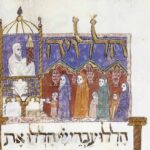Millions of Jews, if they are paying any attention at all at the Seder, must have wondered from time to time what is meant by the Haggadah when it ‘explains’ the words ובזרע נטויה (with an outstretched arm) by the comment זו החרב (this is the sword). Sure, it quotes a verse proving that an outstretched arm can hold a sword and, indeed, the imagery is clear enough anyway. G-d isn’t holding up His arm to play baseball. But once we have solved the question of how the midrash works, we still have to ask what it actually means. What is the sword? When the Haggadah says זה הדם we understand easily that this refers to the plague of blood, even if we may wonder why it is singled out, but there is no sword in the entire story of the exodus.
Here follows a list of every answer to this question that I have been able to track down.
- ‘Sword’ is a metophorical term used throughout the Tanach to refer to vengeance. The Maggid is therefore explaining the term outstretched arm as a reference to G-d’s vengeance generally against the Egyptians. (Ritva)
- ‘Sword’ is a reference specifically to the plague of the first born, since the image of a sword evokes the concept of death. (Ra’avan)
- The Maggid is alluding to a midrashic explanation of Tehilim (136:10) according to which Egyptian firstborn took up swords and rebelled in a desperate attempt to prevent the plague of the firstborn from happening by forcing their fathers to free the children of Israel. (Shibolei haLeqet, Orhot Hayyim and Avudraham)
- The Maggid is alluding to Moshe’s plea to Pharaoh in Shemot 5:3, ‘lest he strike us with the plague or the sword’, which should be interpreted as an oblique threat against Pharaoh. (Rashbatz)
- This part of the Maggid is talking about signs and wonders aimed not at the Egyptians, but the children of Israel. The sword specifically refers either to G-d’s threat to strike the children of Israel if they refused to leave Egypt (Shemot 5:3) or to the midrashic tradition in which a majority of Israelites in Egypt died prior to the exodus. (David Henshke, Shmuel Hain)
- It doesn’t really mean anything. An editor of the Haggadah found a d’rasha in Sifrei talking about something else entirely (specifically Ezekiel’s warnings to the Jews of the first exile) which quotes the verse in Divrei haYamim in order to connect בזרע נטויה with חרב, that is to say military invasion. He then copied it into the Haggadah without any thought about how it might relate to the exodus story. (Joshua Kulp, Shechter Haggadah)
- The Maggid is alluding to the above d’rasha in Sifrei and wants to remind the reader that if the Jews do not keep G-d’s covenant in exile, they will be punished (David Arnow).
- The Maggid is to be understood with reference to a passage in the Zohar according to which we can understand that the avenging angel was given authority (‘the sword’) to visit the last five plague upon the Egyptians whether or not they repented (Ma’aseh Nisim).
- A logical response by Pharaoh to the plagues would have been to simply exterminate the children of Israel. In order to forestall this possibility, G-d put Pharaoh’s government into chaos by killing his ministers one after another. This slow-motion slaughter of Pharoah’s government is alluded to by the Haggadah through the term ‘sword’ (Netziv).
So which of these answers is correct? The answer is that none of them are, though Rashbatz pointed in the right direction and Shmuel Hain misses by a hair. The Maggid is, indeed, making a reference to Shemot 5:3, but in order to understand why you have to stop looking for hidden messages and simply read the Maggid in the way it was intended to be read.
Start here to see what that means, go here for a comprehensive explanation, or just go straight to the Haggadah.



Leave a Reply